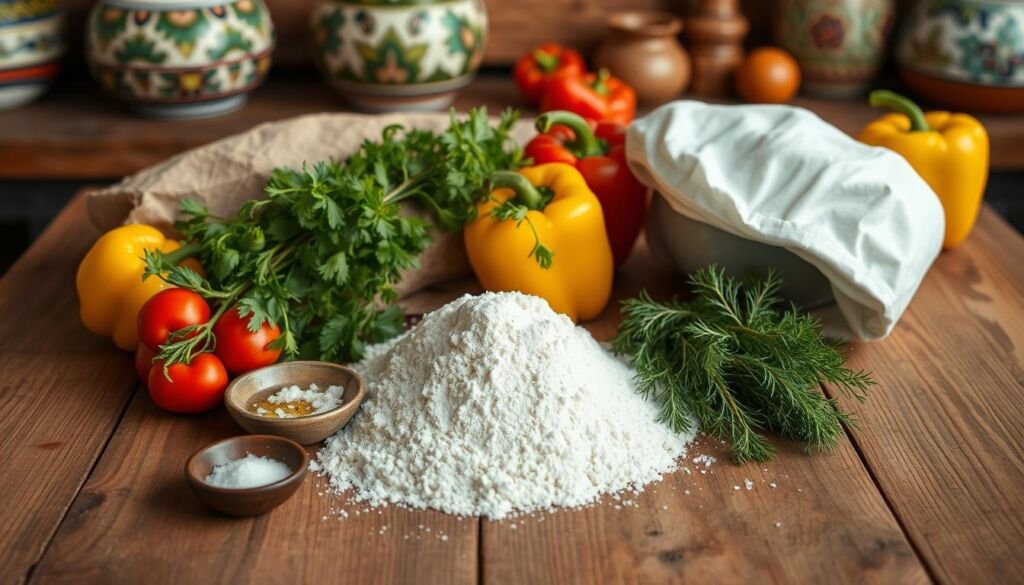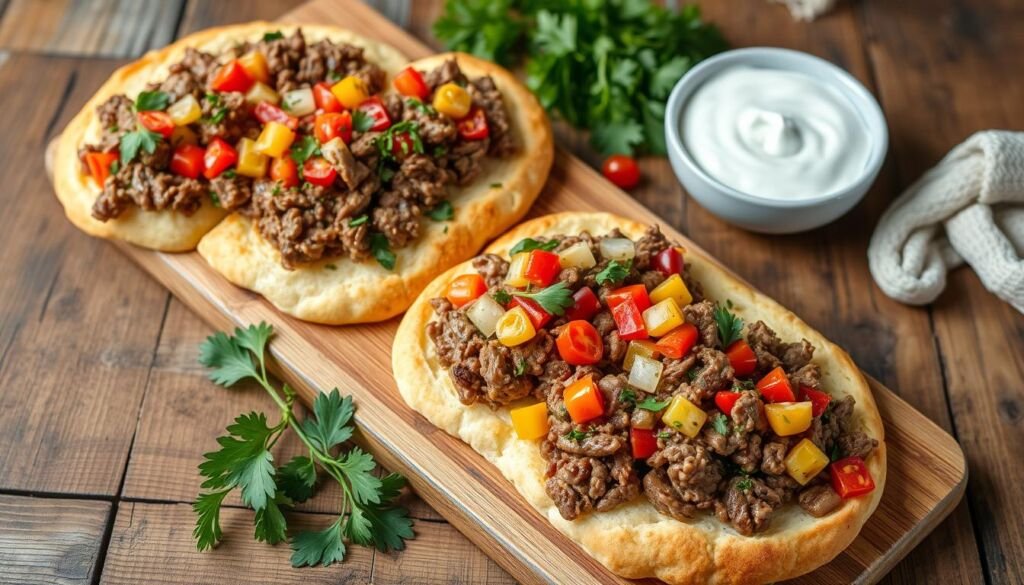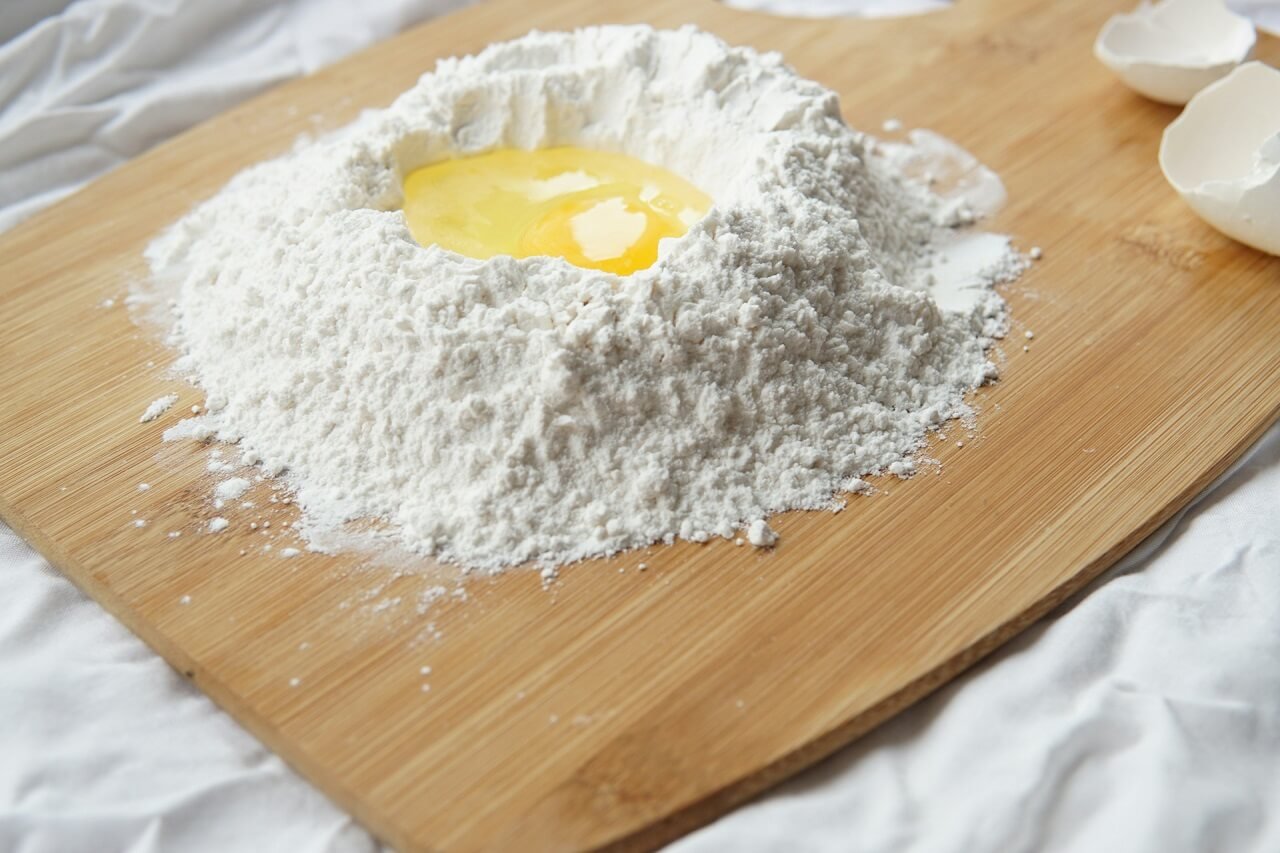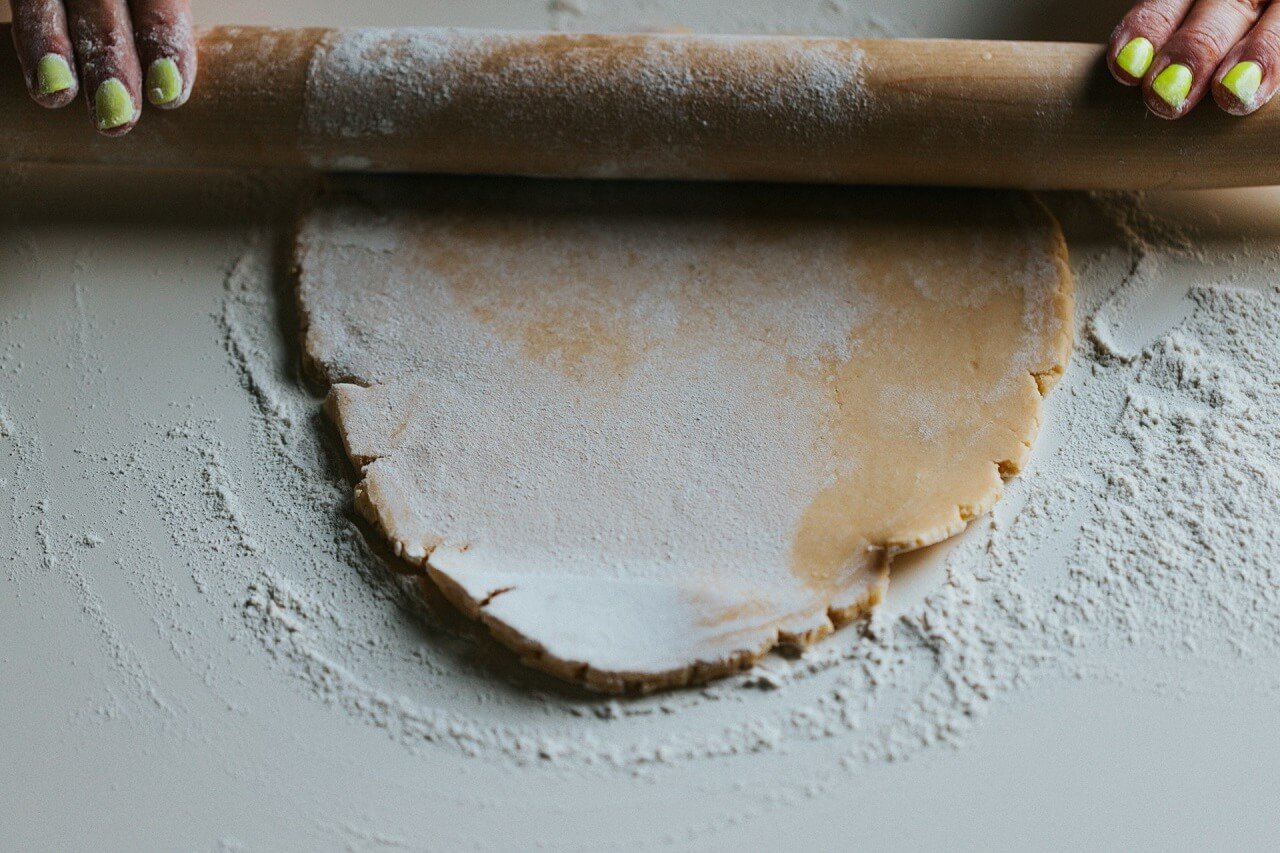Turkish Pide Bread: Step-by-Step Recipe and Health Benefits
Table of Contents
ToggleLooking for a savory flatbread that’s full of flavor? Turkish pide bread is your answer.
This oval-shaped bread is a key part of Turkish cuisine. It’s known for its fluffy texture and many uses.
Pide bread is often filled with tasty toppings. You might find melty cheese, spiced meat, fresh spinach, or herbs inside.
What makes Turkish pide bread special is its shape and how it’s made. The dough is stretched thin and folded over the filling. This creates a boat-like shape.
Pide is then baked in a stone oven. It becomes golden brown and crispy on the outside. But it stays soft and chewy inside. This mix of flavors and textures makes pide a satisfying meal.
Enjoy pide bread as a quick snack or a hearty meal. Its versatility lets you customize it to your liking. It’s a favorite among food lovers everywhere. So, why not try Turkish pide bread and see for yourself?
History and Origins of Turkish Pide Bread
Turkish pide bread is a beloved staple in traditional Turkish cuisine. It has a rich history that spans centuries. Its origins trace back to the Ottoman Empire, where it became a popular bread variety.
In Ramadan, pide bread is often chosen to break the fast. Its soft, fluffy texture and satisfying flavor make it perfect with many dishes. The word “pide” comes from “pide ekmek,” meaning “bread with filling.”
As the Ottoman Empire grew, so did Turkish cuisine’s influence. Pide bread, along with other Turkish delicacies, spread to many regions. This led to regional variations, each with its own unique characteristics and fillings.
“Pide bread is not just a food; it’s a cultural icon that represents the rich history and diversity of Turkey.” – Mehmet Yilmaz, Turkish culinary historian
Some notable regional variations of Turkish pide bread include:
- Black Sea Pide: Known for its boat-like shape and generous use of cheese and butter.
- Kayseri Pide: Famous for its thin, crispy crust and spicy meat filling.
- Konya Pide: Features a soft, pillowy texture and is often filled with ground beef, onions, and tomatoes.
These variations show pide bread’s adaptability and versatility. They reflect Turkey’s diverse culinary traditions. Today, pide bread is cherished in traditional Turkish cuisine, enjoyed by locals and tourists alike.
Essential Ingredients for Authentic Turkish Pide Bread
To make the perfect Turkish pide bread, you need a few key ingredients. Bread flour is the base, with more protein for a chewier dough. Instant yeast is key for a light and airy texture. Warm milk and water help the dough come together.

Olive oil adds richness and depth to the bread. It keeps the bread moist and tender. Sugar and salt balance the flavors, with sugar adding sweetness and salt enhancing taste. Yogurt makes the bread soft and slightly tangy.
An egg wash gives the bread its golden color and glossy finish. The egg wash is made with egg yolk and yogurt. It adds color and aroma. Before baking, sesame or nigella seeds are sprinkled on top for crunch and flavor.
The combination of these essential ingredients creates a harmonious blend of flavors and textures that make Turkish pide bread a true culinary delight.
When making Turkish pide bread at home, have these ingredients ready:
- Bread flour
- Instant yeast
- Olive oil
- Warm milk
- Yogurt
- Egg
- Sugar
- Salt
- Sesame seeds or nigella seeds (optional)
With these authentic ingredients, you’ll make a Turkish pide bread as good as Istanbul’s.
Step-by-Step Guide to Making Turkish Pide Bread at Home
Making Turkish pide bread at home is a rewarding experience. It lets you enjoy the authentic flavors of this beloved bread. With a few simple steps and ingredients, you can create a delicious pide bread that will impress your family and friends. Let’s dive into the process of making Turkish pide bread from scratch.
Start by gathering all the necessary ingredients for your dough. In a large bowl, mix together the dry ingredients like flour, yeast, sugar, and salt.
Add the warm water and olive oil to the dry mixture, stirring until a soft dough forms. Knead the dough on a floured surface for about 10 minutes, until it becomes smooth and elastic.
After kneading, place the dough in a lightly oiled bowl. Cover it with a damp towel. Let the dough rest and rise in a warm place for about an hour, or until it has doubled in size.
This proofing process is crucial for achieving a light and airy texture in your pide bread.
Once the dough has risen, punch it down and divide it into equal portions. Shape each portion into a ball and let them rest for an additional 10 minutes. This resting period allows the gluten to relax, making the dough easier to shape.
Now, it’s time for shaping your pide bread. On a floured surface, roll out each dough ball into an oval shape, about 1/4 inch thick. Using your fingertips, create indentations or dimples on the surface of the dough, giving it a rustic appearance.
“The key to a perfect pide bread is in the shaping. Take your time and create those beautiful indentations that will hold the delicious filling.”
Preheat your oven to 450°F (230°C) and prepare your desired filling. Traditional Turkish pide bread fillings include ground meat, cheese, spinach, or a combination of these ingredients. Spread the filling evenly over the shaped dough, leaving a small border around the edges.
Carefully transfer the filled pide bread onto a baking sheet lined with parchment paper. Bake the pide bread in the preheated oven for 10-15 minutes, or until the crust turns golden brown and the filling is cooked through.
- Brush the edges of the pide bread with a mixture of beaten egg and yogurt for a glossy finish.
- Sprinkle sesame seeds or nigella seeds on top for added flavor and texture.
- Keep an eye on the pide bread during baking to ensure it doesn’t overcook or burn.
Once your Turkish pide bread is baked to perfection, remove it from the oven. Let it cool slightly on a wire rack.
Serve the pide bread warm, sliced into generous portions, and enjoy the delightful combination of flavors and textures.
With practice and experimentation, you’ll soon master the art of making Turkish pide bread at home. The aroma of freshly baked bread will fill your kitchen, and the satisfaction of creating this traditional delight from scratch will be unmatched.
Tips and Tricks for Perfecting Your Turkish Pide Bread
Making Turkish pide bread is all about patience and detail. Getting the dough right is key. It should be smooth and elastic, not too sticky or dry. If it’s off, adjust with flour or water.
Knead the dough until it’s soft and bounces back. This makes it perfect for shaping.
Letting the dough rise is crucial for a light texture. Cover it with a damp cloth and rise in a warm place for an hour. Then, punch it down and let it rise again for 30 minutes before shaping.

Oven temperature is important for baking. Preheat to 400°F (200°C) for the best results. Use a baking stone or steel for a crispy base. If not, a regular baking sheet works too.
For a crunchy surface, sprinkle semolina or cornmeal on the baking surface. This prevents sticking and adds crunch.
The key to perfect Turkish pide bread is a combination of the right ingredients, proper technique, and a little bit of love.
To keep your pide bread soft, cover it with a damp paper towel after baking. This traps steam and keeps it moist. Store leftover pide in a plastic bag or bread bag at room temperature for up to 2 days. For longer storage, refrigerate for up to a week.
| Tip | Description |
|---|---|
| Dough Consistency | Smooth, elastic, not too sticky or dry |
| Rising Time | Allow dough to double in size, then punch down and rise again |
| Oven Temperature | Preheat to 400°F (200°C) for optimal results |
| Baking Surface | Use a baking stone or steel for a crispy base, or sprinkle semolina on a baking sheet |
| Storing | Cover with a damp paper towel, store in a plastic bag at room temperature for 2 days or in the refrigerator for up to a week |
Follow these tips to make delicious Turkish pide bread. Remember, practice makes perfect. Don’t worry if your first try isn’t perfect. Keep trying, and you’ll soon be a pro!
Variations and Toppings to Elevate Your Pide Bread Experience
One of the best things about Turkish pide bread is its versatility. You can try different toppings and fillings to match your taste. Popular choices include Turkish cheeses like kasar and akkawi, or a mix of cheese and sucuk (Turkish sausage). Spiced ground beef or lamb with veggies is also a classic, while spinach and feta make a tasty vegetarian option.

Don’t be afraid to get creative and add your favorite ingredients. Try roasted eggplant, peppers, onions, or even a cracked egg on top. The possibilities are endless, making every pide bread experience unique.
| Topping | Description |
|---|---|
| Cheese | A blend of Turkish cheeses like kasar and akkawi for a rich, creamy flavor. |
| Sucuk | Spicy Turkish sausage paired with cheese for a savory and flavorful combination. |
| Ground Beef | Seasoned ground beef or lamb with vegetables, creating a hearty and satisfying filling. |
| Spinach | A vegetarian option featuring fresh spinach and tangy feta cheese. |
The beauty of Turkish pide bread lies in its adaptability. Whether you prefer meat, cheese, or vegetarian options, there’s a pide bread topping that will satisfy your cravings.
Here are some more topping ideas to inspire you:
- Diced tomatoes and herbs
- Caramelized onions and mushrooms
- Grilled chicken and vegetables
- Smoked salmon and cream cheese
- Nutella and sliced bananas for a sweet treat
Remember, the key to a great pide bread is balancing flavors and textures. This ensures each bite is a perfect mix of ingredients. So, let your imagination soar and make your own unique pide bread creations. They’ll surely impress your family and friends.
The Cultural Significance of Turkish Pide Bread
In Turkish culture, pide bread is very special, especially during Ramadan. Bakeries in Turkey are busy making fresh pide bread for iftar meals. The smell of warm, golden pide bread fills the air, making everyone excited for the meal at sunset.
Sharing pide bread is key during Ramadan in Turkey. Families, friends, and neighbors come together to break their fast. They enjoy pide bread with many tasty dishes. This tradition brings everyone closer, showing the value of sharing and kindness during Ramadan.
“Pide bread is not just a staple food in Turkey; it is a symbol of our culture and the way we come together as a community, especially during Ramadan.” – Ahmet Yilmaz, a local baker in Istanbul.
Pide bread is important all year, not just in Ramadan. It’s often served with main dishes, soups, and dips. Its flexibility makes it great with many flavors, from meats and veggies to hummus and yogurt.
Pide bread is also key in Turkish hospitality. When guests arrive, they’re welcomed with warm smiles and fresh pide bread. This shows the host’s wish to make guests feel at home and well-fed.
- Pide bread is a symbol of sharing and generosity in Turkish culture
- It brings people together during Ramadan and throughout the year
- Pide bread is a staple at Turkish tables and a crucial part of Turkish hospitality
In conclusion, Turkish pide bread is more than food; it’s a cultural icon. It represents sharing, community, and hospitality. Its role in Ramadan and throughout the year highlights its importance in Turkish culture and heritage.
Serving Suggestions and Pairings for Turkish Pide Bread
Turkish pide bread is great for many meals. Enjoy it with cheese, butter, jam, or honey for breakfast. For a bigger breakfast, try it with menemen, a Turkish egg dish with tomatoes and peppers.
Pide bread is perfect for a meze platter.
Tear it into pieces to scoop up dips like hummus or haydari. Its softness and light flavor are great for trying different meze.
Pide bread is also great with soups. It’s sturdy enough for soups like mercimek çorbası or işkembe çorbası. The bread soaks up the soup’s flavors, making each spoonful better.
No Turkish meal is complete without a glass of çay (tea) or a refreshing cup of ayran, a yogurt-based drink that perfectly complements the flavors of pide bread and its various accompaniments.
To make your Turkish meal better, try these ideas:
- Warm the pide bread before serving to enhance its aroma and texture.
- Brush the bread with olive oil and sprinkle it with sesame seeds or za’atar for added flavor.
- Create mini sandwiches by stuffing pide bread with feta cheese, tomatoes, and fresh herbs.
- Use leftover pide bread to make croutons for salads or as a base for bread pudding.
| Pairing | Description |
|---|---|
| Breakfast | Serve with cheese, butter, jam, honey, or menemen |
| Meze | Pair with hummus, baba ghanoush, haydari, and other dips |
| Soups | Dunk into mercimek çorbası (red lentil soup) or işkembe çorbası (tripe soup) |
| Beverages | Enjoy with Turkish tea or ayran (yogurt drink) |
Turkish pide bread is versatile and pairs well with many dishes. It’s a must-try for food lovers. Explore its many flavors and textures.
Health Benefits of Including Turkish Pide Bread in Your Diet
Turkish pide bread can be a tasty and healthy choice if eaten in moderation. It’s made with whole wheat flour, which adds fiber. This fiber helps with digestion and keeps you full longer. Whole wheat flour also has vitamins and minerals that are good for your health.
Be careful with what you put on your pide bread to stay healthy. Choose lean proteins like chicken or turkey, and add fresh veggies like spinach and tomatoes. Use cheese sparingly. This way, you can enjoy the bread’s flavors without too many calories or fats.
It’s important to control how much pide bread you eat. Instead of eating the whole thing at once, share it or save half for later. This way, you can enjoy it without eating too much.
Moderation is the key to enjoying Turkish pide bread as part of a balanced diet. By making mindful choices and paying attention to portion sizes, you can reap the health benefits of this tasty treat.
A healthy diet has lots of different foods. Add Turkish pide bread to your meals with fruits, veggies, lean proteins, and healthy fats. This mix ensures you get all the nutrients your body needs.
Where to Find the Best Turkish Pide Bread Around the World
Looking for the best Turkish pide bread is a fun journey, no matter where you are. In places with lots of Turkish people, you’ll find many bakeries and Turkish restaurants. They’re proud of their recipes, passed down for generations, making each bite a true taste of tradition.
In Istanbul, the heart of Turkish food, you’ll find endless options for pide bread. The city is full of bakeries, each with its own twist on this classic. From Karaköy’s busy streets to Sultanahmet’s historic areas, the smell of fresh pide will draw you in.
Street food vendors also offer great pide bread on the go. They fill their pide with cheese, meats, or veggies, making it a tasty snack for exploring the city.
If you can’t find Turkish bakeries or restaurants, don’t worry. The internet has many recipes to make pide bread at home. With practice and the right ingredients, you can make this iconic bread. Try different toppings to find your favorite, and impress your loved ones with your baking skills.
“Turkish pide bread is not just a simple staple; it’s a culinary experience that showcases the rich history and flavors of Turkish cuisine. Whether you find it at a local bakery, a bustling Turkish restaurant, or a street food vendor, each bite tells a story of tradition, passion, and deliciousness.”
Here are some top places around the world for amazing Turkish pide bread:
| City | Notable Locations |
|---|---|
| Istanbul, Turkey | Karaköy Güllüoğlu, Hocapaşa Pidecisi, Tarihi Karadeniz Pide Fırını |
| London, UK | Babaji Pide, Pide Oven, Gökyüzü Restaurant |
| New York City, USA | Turkish Kitchen, Sip Sak, Pera Mediterranean Brasserie |
| Sydney, Australia | Hakiki Turkish Bakehouse, Pita Mix, The Pide Co. |
Seeking out the best Turkish pide bread is a journey worth taking. Let your taste buds lead you as you explore this delightful culinary treasure. Discover the authentic flavors and traditions that make Turkish cuisine so loved worldwide.
Turkish Pide Bread: A Culinary Delight Worth Trying Today
Turkish pide bread is more than a simple flatbread. It’s a flavorful treat that combines great taste, texture, and cultural value. You can enjoy it for breakfast, as a main dish, or as a snack with friends and family. Its flexibility lets you try many different fillings and toppings to find your favorite.
Trying Turkish pide bread, whether at a restaurant or making it yourself, is a flavorful journey. It celebrates Turkey’s rich culinary history. Making pide bread is a cultural experience, where you learn traditional techniques and use ingredients passed down through generations.
So, why not try Turkish pide bread today? It’s a delicious way to explore Turkish cuisine and its traditions. By trying pide bread, you’ll not only enjoy great flavors but also learn to appreciate Turkish food more. Start your culinary journey with Turkish pide bread and enjoy its deliciousness now and in the future.
What is Turkish pide bread?
Turkish pide bread is a savory flatbread shaped like an oval. It’s filled with cheese, sausage, spiced meat, and spinach. It’s like a Turkish pizza but has a fluffier dough than gozleme.
How do you pronounce “pide” and what does it mean?
“Pide” is pronounced as “pee-dae”. It comes from the Turkish “pide ekmek”, meaning “bread with filling”.
What are the essential ingredients for making authentic Turkish pide bread?
You need bread flour, instant dry yeast, warm milk, water, and olive oil. Also, sugar, salt, an egg, yogurt, and sesame or nigella seeds for topping.
How do you make Turkish pide bread at home?
Mix dry ingredients, add wet ingredients to form dough. Knead until smooth, let it rise, then shape into ovals. Add filling, fold edges, and bake until golden.
What are some tips for achieving the perfect Turkish pide bread?
Focus on dough consistency and rising time. Preheat oven correctly. Use a baking stone for crispiness. Cover with a damp paper towel to keep soft.




